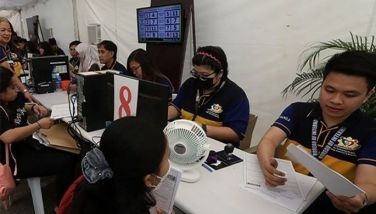Picking on the wrong people

MANILA, Philippines — The new round of water rationing resorted to by the two water concessionaires due to the low water level at Angat Dam in Bulacan brings to fore a huge problem which has been left unaddressed by our government for decades now – the absence of a new water source.
No less than the head of the National Water Resources Board has claimed that government had been slow to find alternatives to Angat Dam, which supplies as much as 97 percent of the water requirements of Metro Manila and portions of nearby provinces.
Even Metropolitan Waterworks and Sewerage System chief regulator Patrick Ty himself has admitted that government was partly to blame for the water shortage because of its failure to do what had been on the drawing board way back a half-century ago, which is to build an alternative water source for Metro Manila’s ever-burgeoning population.
As early as the ‘70s, a number of alternative water sources have already been identified, including the Kaliwa Dam in Quezon and the Laiban Dam in Rizal. Government at present reportedly wants to accelerate the implementation of the New Centennial Water Source project (Kaliwa and Laiban) but opposition from environmental and indigenous peoples’ groups has kept the project from moving forward.
Some critics have been blaming Maynilad and Manila Water for failing to build a new water source. They have refused to acknowledge the fact that the two are mere water distributors and that it is the job of the MWSS to look for one.
MWSS knew for decades that reliance on Angat Dam had to end soon. Various international organizations have produced studies warning our government that dams only last 50 years. Angat Dam was built in the ‘60s which means that it is way past its useful life. The dam’s reservoir also lies on top of a fault line and cracks have already weakened the dam. Fortunately, strengthening or rehabilitation works have extended its usefulness. But for how long?
For its part, Maynilad last week pointed out that as a water distributor, it can only distribute the water volume it receives from raw water sources. It said that government has claimed responsibility for the development of raw water sources, but the water concessionaires have been working with them to expedite the process because of the urgency of meeting the supply needs of their customers.
Two months ago, Reps. Luis Campos Jr. and Winston Castelo said the administration of former president Noynoy Aquino should share the blame for the worsening water crisis because his government rejected several proposals in 2012 to undertake long-term solutions to preempt the problem for being redundant. Wouldn’t it be better for consumers to have an oversupply of water than suffer from lack of it?
Aside from wrongfully blaming them for failing to develop new water sources, the two concessionaires are also being wrongly blamed for the lack of sewerage and wastewater treatment systems for Metro Manila’s 14 million water consumers.
Maynilad has spent P46.7-billion on wastewater treatment facilities since 1997 even if it has collected only P38.07 billion in sewage fees over same period. It is also setting aside P200 billion to build 26 new STPs and install 425 kilometers of new sewer lines from 2019 to 2037.
Maynila and Manila Water could have done more in the area of sewerage and wastewater treatment, if only other government agencies who are also tasked to implement the Clean Water Act have done their job.
Thus, Maynilad and MWC have not been remiss in their tasks as claimed by their critics who have heaped the blame solely on the two concessionaires for the failure to build enough STPs and other wastewater treatment facilities as mandated under the CWA.
Recently, the Supreme Court ordered both Maynilad and MWC to pay a fine of P921.5 million for violating the CWA, which the two are appealing because they were given by the SC in an earlier ruling until 2037 to complete their task.
The Department of Environment and Natural Resources, the lead agency responsible for implementing the CWA, has not even drawn up a Water Quality Management Area (WQMA) Action Plan, which includes setting the goals and targets for a sewerage or septage program. How can the DENR blame the two concessionaires, let alone impose multimillion-peso penalties against them, when it is the one that has bungled its job under the CWA?
HOUSING SCAM
The Iloilo City government has a lot of explaining to do in connection with a multi-million peso low-cost housing project turned ghost project.
The project, which called for the construction of 413 low-cost housing units in the Pavia district, was funded via a P125-million bond flotation in 2001. The debt has since then ballooned to P137 million, with interest mounting as the years go by, and the burden of paying more resting on the shoulders of taxpayers.
To date, not a single unit has been built.
In 2002, the project’s subcontractors abandoned their work, claiming that the contractor ABE Builders did not pay a single centavo. cent. The complaint reached the Iloilo city council, which the following year recommended rescinding the contract with ABE Builders, requiring the contractor to pay damages, and charging certain city officials and the contractor for graft, including ex-mayor Mansueto Malabor, incumbent mayor Jerry Treñas, and the contractor.
In 2005, the Deputy Ombudsman for the Visayas Primo Miro resolved to suspend some city officials and indict them before the Sandidanbayan. Five years later, OIC and Deputy Ombudsman Orlando Casimiro gave the go-ahead to the Miro resolution but removed Treñas and several others from the list of city officials to be indicted. Casimiro also ordered the Ombudsman-Visayas office to dig deeper into the Iloilo housing scam.
Until now, Iloilo City residents are still waiting for answers.
FALSE INFORMATION
Just recently, officials of a major beauty supplements company filed a complaint against several individuals who have allegedly been spreading false information on social media.
Noveau Philippines Corp. and Noveau Japan Co. Ltd. lodged a cyberlibel complaint before the NBI accompanied by their lawyers Ferdinand Topacio at Julius Danas.
In the complaint submitted to Special Investigator Rojun Hosillos of the NBI cybercrime division and agent in charge Baden Alonzo, Noveau Philippines claimed that several posts on Facebook pointed to them as being involved in in estafa while the Japan firm was accused on social media of being under surveillance by the Securities and Exchange Surveillance Commission in Japan for unsound business practices.
The two companies said there was absolutely no truth to these information being spread about them on social media.
NBI investigations revealed that among those involved in the dissemination of false information about the two companies on social media are individuals going by the name of Beverly Santos, Karen Gabriel, Avelina Obregon, Stella MarieAncla, alias Gerry Yap, and alias Chloe.
For comments, e-mail at [email protected]
- Latest
- Trending































